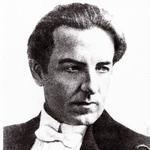Name Eduard Sormus | Role Musical Artist | |
 | ||
Died August 16, 1940, Moscow, Russia | ||
Eduard Sõrmus (July 9, 1878 — August 16, 1940) was an early 20th-century Estonian violinist. He was sometimes known as the Red Violinist (der rote Geiger).

Sõrmus was born in the Luunja borough, Tartu County, Estonia. He inherited part of his interest for music from his mother Leena, who had a lovely singing voice and who used to sing during her daily tasks. When Sõrmus was 6 years old, his father gave him his first violin. Sõrmus´s first music teacher was a local tailor named Gustav Puks. Sõrmus went to Hugo Treffner Gymnasium in Tartu from 1888. In gymnasium, he continued playing violin with Johann Kelder, who was a medical student in the University of Tartu. Sõrmus then gave his first concerts in his farmstead and in a neighbouring house. In 1899, Sõrmus went to university and started studying law at the university. After a year in the faculty of law, he changed his studies over to history and languages. In 1902, Sõrmus continued his violin studies at the Saint Petersburg Conservatory under the hand of violin master Leopold Auer. Sõrmus became active in the Russian Revolutionary movement and eventually took part in the 1905 Russian Revolution. In 1904, he began touring, giving violin recitals and giving ardent speeches of proletarian sufferings and miseries. That was enough to be listed in the police's list of most wanted. In 1906, because of his revolutionary activity, he was forced to flee Russia, so he toured Europe giving recitals. After this he continued his studies with Henri Marteau in Berlin and Lucien Capet in Paris. Sõrmus spent World War I in Paris and London, after which he returned to Russia for a couple of years and then toured the continent again. One concert was held in Edinburgh, Scotland, in 1934 where his wife, Virginia, played the pianoforte. He died in a nursing home in Moscow whilst his wife, Virginia, was visiting her family in Britain.
Sõrmus was a labour activist. He gave a number of charity concerts, the proceeds of which went to help the poor, and concerts to children. Near Dresden, there is a children´s orphanage which was built with donation money collected during Sõrmus's concerts.
In the 1920s, he was mainly active in Germany. There is a street named after him (Eduard-Soermus-Straße) in the city of Zwickau, Schumann's birthplace.
The 1912 Marc Chagall painting Der Geiger was inspired by Sõrmus.
